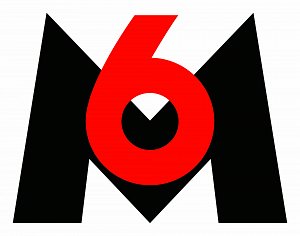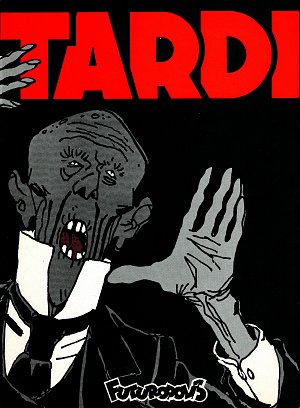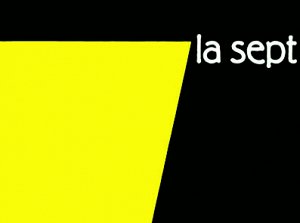
M6 logo, On/Off productions 1987
© Étienne Robial
Born in Rouen in 1945, Étienne Robial
studied at the École des Beaux-Arts
in Rouen and at the École des Arts
et Métiers in Vevey, Switzerland.
He started his career in 1970 as artistic
director for the Barclay record label
and Editions Filipacchi, helped design
the initial concept for Le Point, and
redesigned the artwork for Télérama.

Tardi, One of the first Futuropolis titles
© Étienne Robial
In 1972, after buying a bookstore
specializing in comics, he co-founded
the Futuropolis publishing house with
Florence Cestac and worked to gain
recognition for “auteur” comic books
with authors such as Tardi, Bilal, Moebius,
Götting, Joost Swarte, Ever Meulen,
Baudoin, Menu, Chauzy, Jeanne Puchol
and Miles Hyman, to name a few.
He pursued his publishing activity
until 1994, before selling the business
to Editions Gallimard.
Alongside his Futuropolis adventure,
he founded the On/Off production
studio in 1982, where he designed
the “habillage” – a termed he coined
for audiovisual presentations – for
major television stations like Canal+,
where he remained general artistic
director from its creation in 1984 until
2009. He designed the logo for the
group’s stations, 4,700 main titles and
an immediately identifiable graphic
system.

La Sept logo, On/Off productions 1986
© Étienne Robial
He is also the man behind
the presentations for La Sept (1986)
and M6 (1987), as well as RTL9 (1995)
and I-Télé (2003). More recently,
he created the artwork for the magazine
Les Inrockuptibles and the brand L’Équipe.
He has also created the graphic identities
of various sports and cultural institutions –
the PSG (Paris-Saint Germain football
club), the CNC (Centre National du Cinéma
et de l’Image Animée), the RSA (Revenu
de Solidarité Active) – and enhanced
their evolving graphic systems. In 2006,
he received the Promax Broadcast Design
Outstanding Achievement Award.
For the
past 26 years, he has been a professor
at the Penninghen school of art direction
and interior architecture.
The themed exhibition follows Etienne
Robial’s career from his Futuropolis period
(1972 to 1994) to his Canal+ years with the
founding of the On/Off production studio
(1982 to present).

L’Équipe magazine logo, On/Off productions 2016
© Étienne Robial
The exhibition begins with the Futuropolis
years, shedding light on the work of the
avant-garde comic book publisher through
a selection of book collections by major
authors, as well as drawings, catalogues
and advertising materials.
The exhibition also reveals the creator’s
influences and his personal, artistic
world. An avid collector, Étienne Robial
has put together an extensive collective
of designer pieces from the modernist
and functionalist movements of the 20th
century (chairs by Mallet-Stevens, Mart
Stam and Gerrit Rietveld, glassware
by Wilhelm Wagenfeld, lamp by Marianne
Brandt, alarm clock and calculators
by Dieter Rams for Braun, among others)
that punctuate the exhibition, along
with the essential tools for any graphic
creation: rulers, triangles, T-squares, ruling
pens, compasses, drawing pencils and
mechanical pencils.
-

(A SUIVRE), Cover, 1977
© Étienne Robial
-

Métal Hurlant, Cover 1975
© Étienne Robial
A reproduction of his library bookcases,
featuring collections such as Club
du Livre and Série Noire, reveals his
references, his sources of inspiration and
his “heroes”: Kasimir Malevitch, Jean Arp,
Theo van Doesburg, Josef Albers, Paul
Rand, Max Bill, Willem Sandberg, Bruno
Munari and Ed Ruscha, to name a few.
A section is devoted to education and
Étienne Robial’s distinctive approach
to teaching graphic design to his students.
The exhibition concludes with the three
main pillars of Étienne Robial’s graphic
world: forms, colors, and alphabets. Each
plays a fundamental part in what defines
his work, proportions and a regulating
layout.
The musée des Arts décoratifs, boasting
one of the richest and oldest graphic
art collections in France from the 19th
century to the present day, is pleased
to present the first major retrospective
of one of the leading figures on the French
contemporary graphic art scene.
The museum is pursuing its series
of exhibitions on contemporary graphic
artists, which has included past tributes
to Antoine+Manuel, graphiste et designer
(2009), Michal Batory, artisan de l’affiche
(2011), Typorama, Philippe Apeloig (2013),
and more recently Roman Cieslewicz,
la fabrique des images (2018).